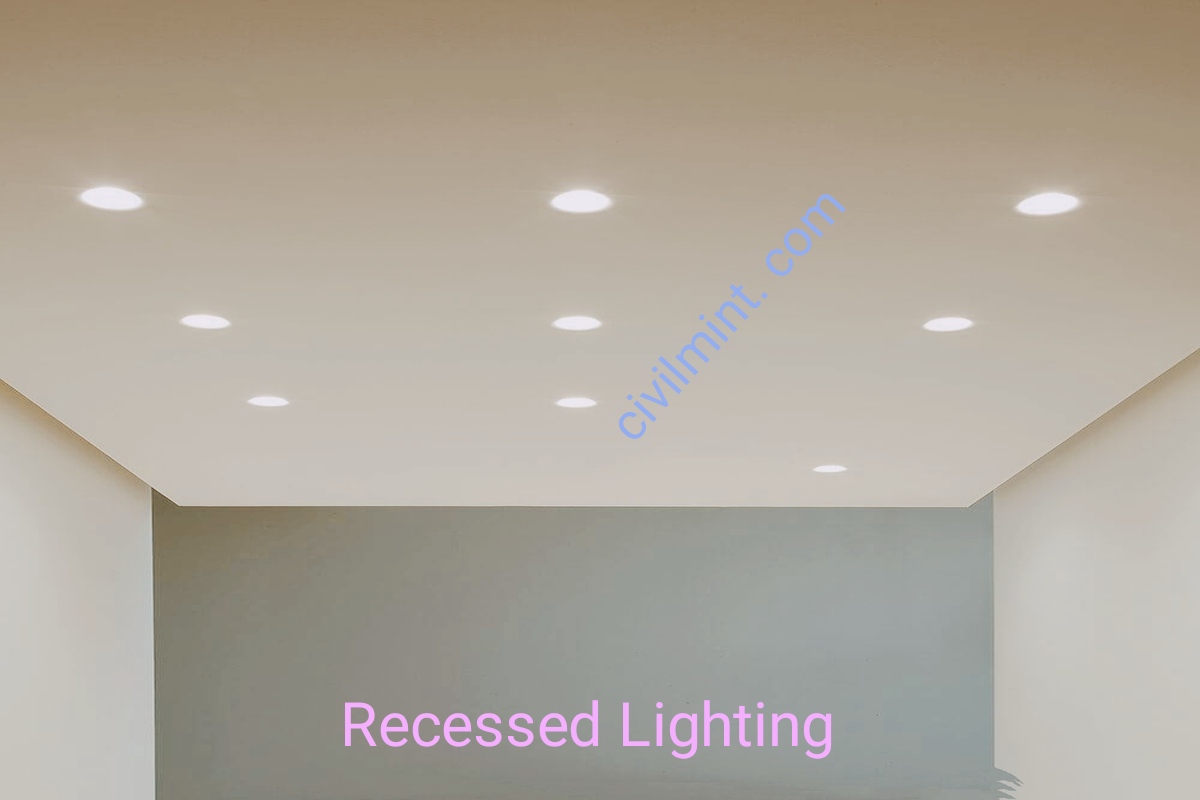Recessed lighting, also referred to as down lighting, is a type of light fixture that is installed above the ceiling line and sits inside a hollow opening. This creates the illusion of light shining out from a hole in the ceiling.

The recessed light is typically directional, with the light shining in a downward direction similar to a broad floodlight or spotlight. It is a metal fixture that is designed to blend seamlessly into the ceiling, providing a sleek and modern look.
Table of Contents
Explanation Of Recessed Lighting
Recessed lighting is a type of light fixture that is installed in a hollow opening in a ceiling, wall, or other surface. The fixture is designed to sit flush with the surface, creating a streamlined and modern look.
One of the advantages of recessed lighting is that it can be used to create a clean and uncluttered appearance in a room. Unlike traditional light fixtures that hang down from the ceiling or protrude from a wall, recessed light fixtures are hidden from view, creating a seamless look.
Recessed lighting is also a great option for rooms with low ceilings, as it doesn’t take up any vertical space. In addition, recessed lighting can be used in large rooms to provide uniform lighting, without the need for multiple fixtures.
There are many types of recessed lighting available, including LED, halogen and incandescent. LED lights are the most energy efficient and long-lasting option, while halogen lights provide bright, white light that is ideal for task lighting. Incandescent lights are the least energy-efficient option, but they provide warm, soft light that is ideal for creating a relaxing atmosphere.
Recessed lighting is a versatile option that can be used in a variety of settings, including living rooms, bedrooms, kitchens, bathrooms and outdoor spaces. With the right types of fixtures and bulbs, recessed lighting can be used to create varying effects and moods, from bright and energizing to warm and relaxing.
Why We Use Recessed Lights?
Recessed lighting is a fantastic choice for illuminating a room with a sleek and minimalistic approach that eliminates clutter. These lights are especially useful in rooms with low ceilings, where hanging fixtures can make the space appear even smaller. By using low voltage recessed lights with MR16 bulbs that offer varying beam spreads, the light can be better controlled in the room than with traditional ceiling lights. The adjustable trims on the recessed cans and the use of low voltage bulbs make it much easier to achieve the desired illumination in a room.
The key advantage of recessed lighting is its ability to provide a clean and uncluttered look. Multiple ceiling lights can be overwhelming and can give the impression of a cluttered space. Recessed cans, on the other hand, blend seamlessly into the ceiling, creating a clean and simple look. This makes them an excellent choice for spaces that require subtle and unobtrusive lighting.
Benefits Of Recessed Lighting
- Recessed lights can easily blend into the given space with no visible fixtures, which makes them an excellent choice for interior design enthusiasts.
- They are the ideal lighting option for rooms with low ceiling heights like basements, as they take up minimal space.
- With proper placement, recessed lights can provide full coverage to a room, unlike ceiling lights that have reduced coverage at the room perimeter.
- Recessed light units can be designed to be waterproof, making them an ideal lighting option for wet locations such as bathrooms.
Some Drawbacks Of Recessed Lighting
- Recessed lights only cover a circular area, which means that they only shine directly below them and cannot extend very far.
- As recessed lights only cover a small area, a significant number of lights may be required to provide sufficient illumination for a room.
- Gaps between the wallboards and the light fixture can cause air to leak through, potentially leading to energy loss.
Conclusion
Recessed lighting is a great option for anyone looking for a minimalistic and elegant lighting solution. By providing an unobtrusive and clutter-free lighting experience, recessed lights can create a serene and calming atmosphere in any room. So, whether you are designing a modern living room or a cozy bedroom, recessed lighting can help you achieve the perfect lighting ambiance.
Faqs
A common rule of thumb is to use one recessed light for every 4 to 6 square feet of ceiling space. This ensures even, overall illumination throughout the kitchen.
The most common size for a recessed light is 6 inches. The standard ceiling cut-out size for a 6-inch housing is 6-3/8 inches, and the inside diameter of the housing (trim removed) measures approximately 6 inches.
Yes, many people are now using a light fixture called a disc light as an alternative to recessed can lights. Disc lights are thin LED lights that are mounted to the surface of the ceiling and are typically only about an inch tall.
The majority of LEDs and recessed downlights have a fairly narrow beam of 40 degrees. Anything within 5 degrees of this is considered standard in the industry. This is in contrast to regular light bulbs, which have a 360-degree beam angle.
